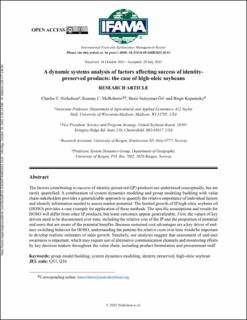| dc.contributor.author | Nicholson, Charles | |
| dc.contributor.author | McRoberts, Keenan | |
| dc.contributor.author | Suleyman Öz, Besir | |
| dc.contributor.author | Kopainsky, Birgit | |
| dc.date.accessioned | 2022-10-24T10:52:12Z | |
| dc.date.available | 2022-10-24T10:52:12Z | |
| dc.date.created | 2022-10-10T22:07:27Z | |
| dc.date.issued | 2022 | |
| dc.identifier.issn | 1096-7508 | |
| dc.identifier.uri | https://hdl.handle.net/11250/3027861 | |
| dc.description.abstract | The factors contributing to success of identity-preserved (IP) products are understood conceptually, but are rarely quantified. A combination of system dynamics modeling and group modeling building with value chain stakeholders provides a generalizable approach to quantify the relative importance of individual factors and identify information needed to assess market potential. The limited growth of IP high-oleic soybean oil (HOSO) provides a case example for application of these methods. The specific assumptions and results for HOSO will differ from other IP products, but some outcomes appear generalizable. First, the values of key drivers need to be documented over time, including the relative cost of the IP and the proportion of potential end users that are aware of the potential benefits. Because sustained cost advantages are a key driver of end-user switching behavior for HOSO, understanding the patterns for relative costs over time would be important to develop realistic estimates of sales growth. Similarly, our analyses suggest that assessment of end-user awareness is important, which may require use of alternative communication channels and monitoring efforts by key decision makers throughout the value chain, including product formulators and procurement staff. | en_US |
| dc.language.iso | eng | en_US |
| dc.publisher | Wageningen Academic Publishers | en_US |
| dc.rights | Navngivelse 4.0 Internasjonal | * |
| dc.rights.uri | http://creativecommons.org/licenses/by/4.0/deed.no | * |
| dc.title | A dynamic systems analysis of factors affecting success of identity-preserved products: the case of high-oleic soybeans | en_US |
| dc.type | Journal article | en_US |
| dc.type | Peer reviewed | en_US |
| dc.description.version | publishedVersion | en_US |
| dc.rights.holder | Copyright 2022 The Author(s) | en_US |
| cristin.ispublished | true | |
| cristin.fulltext | original | |
| cristin.qualitycode | 1 | |
| dc.identifier.doi | https://doi.org/10.22434/IFAMR2021.0132 | |
| dc.identifier.cristin | 2060246 | |
| dc.source.journal | International Food and Agribusiness Management Review | en_US |
| dc.identifier.citation | International Food and Agribusiness Management Review. 2022. | en_US |

